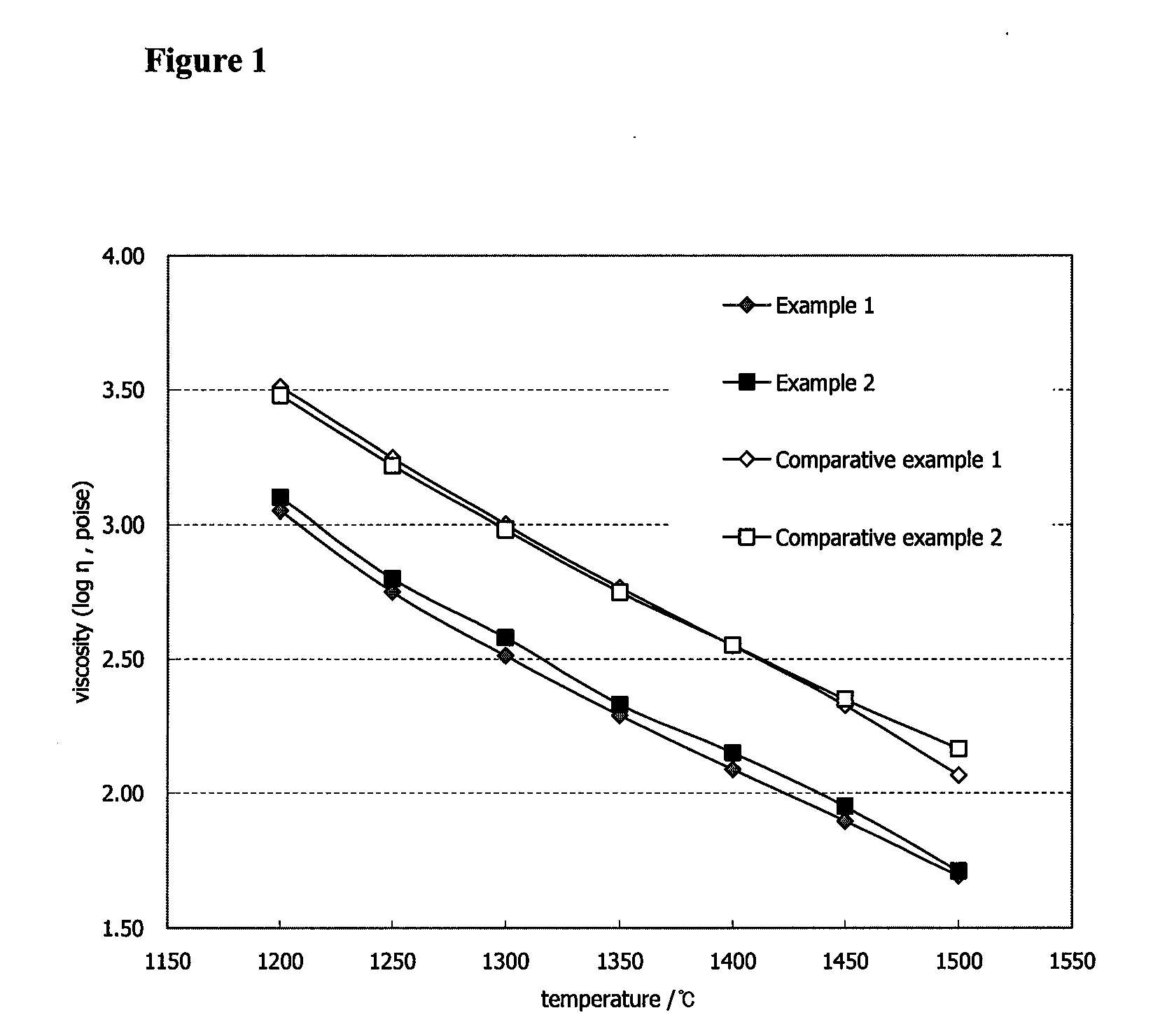High Strain-Point Glass Composition For Substrate
a glass composition and high-strength technology, applied in the field of glass substrates, can solve the problems of soda lime glass not being suitable for glass substrates, the pdp size becomes larger, and the impact of handling and processing becomes important,
Inactive Publication Date: 2008-05-15
KCC CORP CO LTD
View PDF3 Cites 7 Cited by
- Summary
- Abstract
- Description
- Claims
- Application Information
AI Technical Summary
Benefits of technology
[0012]To solve the problems of conventional glass composition as described above, the present inventor has developed a glass composition which has dimensional stability and flatness during heat treatment around 600° C. in the manufacturing of PDP, can use pa
Problems solved by technology
However, the more PDP development proceeds, the larger the PDP size becomes.
Thus, such problems as size deformation by thermal expansion, and scratch during handling and processing became important.
However, soda lime glass is not suitable for a glass substrate due to high thermal deformation rate and high content of Na2O.
Specifically, the strain point of soda lime glass is around 510° C., and thus thermal deformation or decrease of productivity may be easily occurred during heat-treating process.
Another problem of soda lime glass is to have reactivity with Ag electrode in PDP electrodes.
Therefore, soda lime glass had a disadvantage that the above reaction should be inhibited by coating SiO2 on a lower part of a substrate to prevent yellowing phenomenon.
As described above, problems of conventional soda lime glass are the thermal deformation during heat treatment at a high temperature and the reactivity of Ag+ electrode and alkali metal.
However, such change of components content inevitably induced increase of viscosity of glass at a high temperature, which result in a very unfavorable condition in a dissolution process of raw glass materials, a defoaming process of generated foam(fining process), and homogenization of glass melt.
However, this glass composition is very difficult to be practiced because the above Publication does not describe each specific amount of alkali metal oxide and alkali earth metal oxide, with only specifying total amounts.
Excessive use of these components may cause corrosion of electrode or coloration of glass in an electric melting process.
Thus, the composition of the above Publication h
Method used
the structure of the environmentally friendly knitted fabric provided by the present invention; figure 2 Flow chart of the yarn wrapping machine for environmentally friendly knitted fabrics and storage devices; image 3 Is the parameter map of the yarn covering machine
View moreImage
Smart Image Click on the blue labels to locate them in the text.
Smart ImageViewing Examples
Examples
Experimental program
Comparison scheme
Effect test
 Login to View More
Login to View More PUM
| Property | Measurement | Unit |
|---|---|---|
| Temperature | aaaaa | aaaaa |
| Temperature | aaaaa | aaaaa |
| Temperature | aaaaa | aaaaa |
Login to View More
Abstract
The present invention relates to a glass substrate composition comprising SiO2 55˜70 wt %, Al2O3 0˜1 wt %, ZrO2 0.1˜5 wt %, Na2O 0.1˜5 wt %, K2O 7˜13 wt %, MgO 7˜14 wt %, CaO 0˜4 wt %, SrO 7˜12 wt % and SO3 0.01˜0.5 wt %. The glass substrate prepared by using the above composition shows less thermal deformation at a baking process under a high temperature since the strain point of the glass is at least 570° C., does not have such disadvantages as increase of fuel cost and short life cycle of refractories resulted from less than 1460° C. of melting point, and has 80˜95×l0−7/° C. of thermal expansion coefficient in the temperature range of 50˜350° C. Therefore, the glass according to the present invention is suitable as a substrate.
Description
TECHNICAL FIELD[0001]The present invention relates to a glass substrate for Flat Panel Display (FPD), in particular, a glass substrate composition for Plasma Display Panel (PDP). Specifically, the present invention relates to a glass substrate composition comprising SiO2 55˜70 wt %, Al2O3 0˜1 wt %, ZrO2 0.1˜5 wt %, Na2O 0.1˜5 wt %, K2O 7˜13 wt %, MgO 7˜14 wt %, CaO 0˜4 wt %, SrO 7˜12 wt %, and SO3 0.01˜0.5 wt %. The glass prepared by using the above composition shows less thermal deformation during a baking process at a high temperature because the strain point of the glass becomes to 570° C. or more which is much higher than that of soda lime glass used as a glass substrates for conventional plasma display panel. Also, the glass prepared by using the present composition dose not have such disadvantages as increase of fuel cost and short life cycle of refractories since the melting point is less than 1460° C., and the thermal expansion coefficient in the temperature range of 50˜350°...
Claims
the structure of the environmentally friendly knitted fabric provided by the present invention; figure 2 Flow chart of the yarn wrapping machine for environmentally friendly knitted fabrics and storage devices; image 3 Is the parameter map of the yarn covering machine
Login to View More Application Information
Patent Timeline
 Login to View More
Login to View More IPC IPC(8): C03C3/085C03C3/087C03C3/078
CPCC03C3/087C03C3/078H01J17/49G02F1/133302
Inventor LEE, JIN HYUKLEE, SI MOOLEE, JAE WOOK
Owner KCC CORP CO LTD
Features
- R&D
- Intellectual Property
- Life Sciences
- Materials
- Tech Scout
Why Patsnap Eureka
- Unparalleled Data Quality
- Higher Quality Content
- 60% Fewer Hallucinations
Social media
Patsnap Eureka Blog
Learn More Browse by: Latest US Patents, China's latest patents, Technical Efficacy Thesaurus, Application Domain, Technology Topic, Popular Technical Reports.
© 2025 PatSnap. All rights reserved.Legal|Privacy policy|Modern Slavery Act Transparency Statement|Sitemap|About US| Contact US: help@patsnap.com

